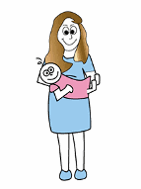Bathing
Many laboring women find bathing decreases the pain of labor. They have used baths for years in out-of-hospital birth settings for both labor and birth. Many hospitals either provide a bath service or allow families to bring in bathing equipment.
Technique
When the laboring woman has entered the active phase of labor (cervical dilation >4 cm) she is placed in a warm water bath. The water, near body temperature (37-38C), should not be above nipple level so proper body cooling can occur.
Duration
Many women find a bath soothing with less labor pain when used for 1-1.5 hours. Studies indicate longer duration does not improve pain and increases the risk of prolonged elevated temperatures on the baby.
Limitations
The fetal body temperature is approximately one degree higher than maternal temperature. Prolonged exposure of the fetus to elevated temperatures may increase fetal morbidity thus it is recommended that water temperature not exceed 37C and duration limited to less than 2 hours per bathing period.
In the event the mothers membranes have ruptured prematurely most studies have shown no increase in infection or antibiotic use with intralabor bathing. More research needs to be done on this practice with ruptured membranes to make recommendations either way.
Further reading:
Simkin P. Nonpharmacologic relief of pain during labor: Systematic reviews of five methods, Am J Obstet gynecol, 2002 Volume 186, Number 5 ,S131-159
Odent M. Water birth: what's next. Electronic response to: Perinatal mortality and morbidity among babies delivered in water: surveillance study and postal survey. Available at www.bmj.com
Odent M Can water immersion stop labor? J Nurse Midwifery 1997;42: 414-16
